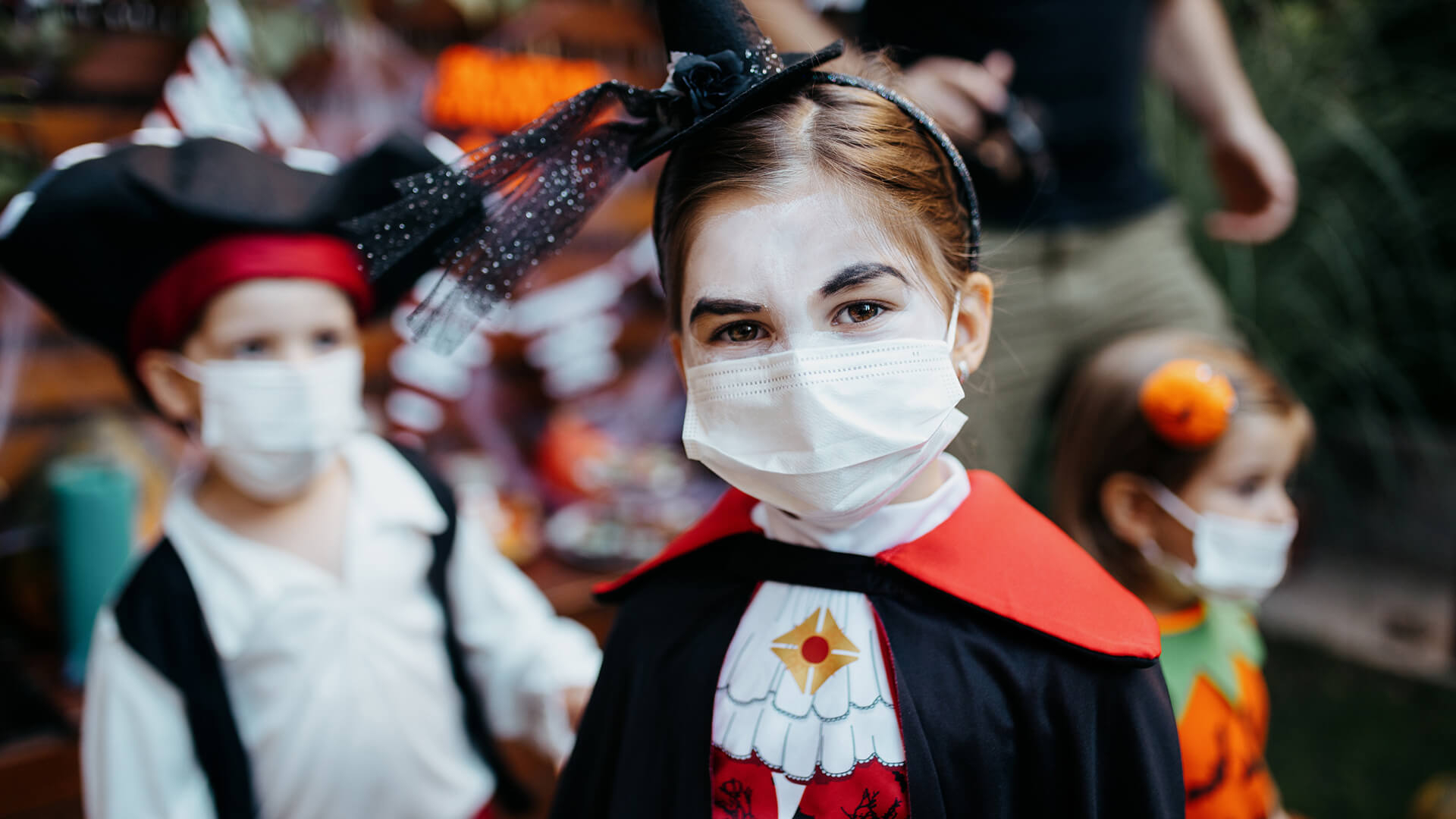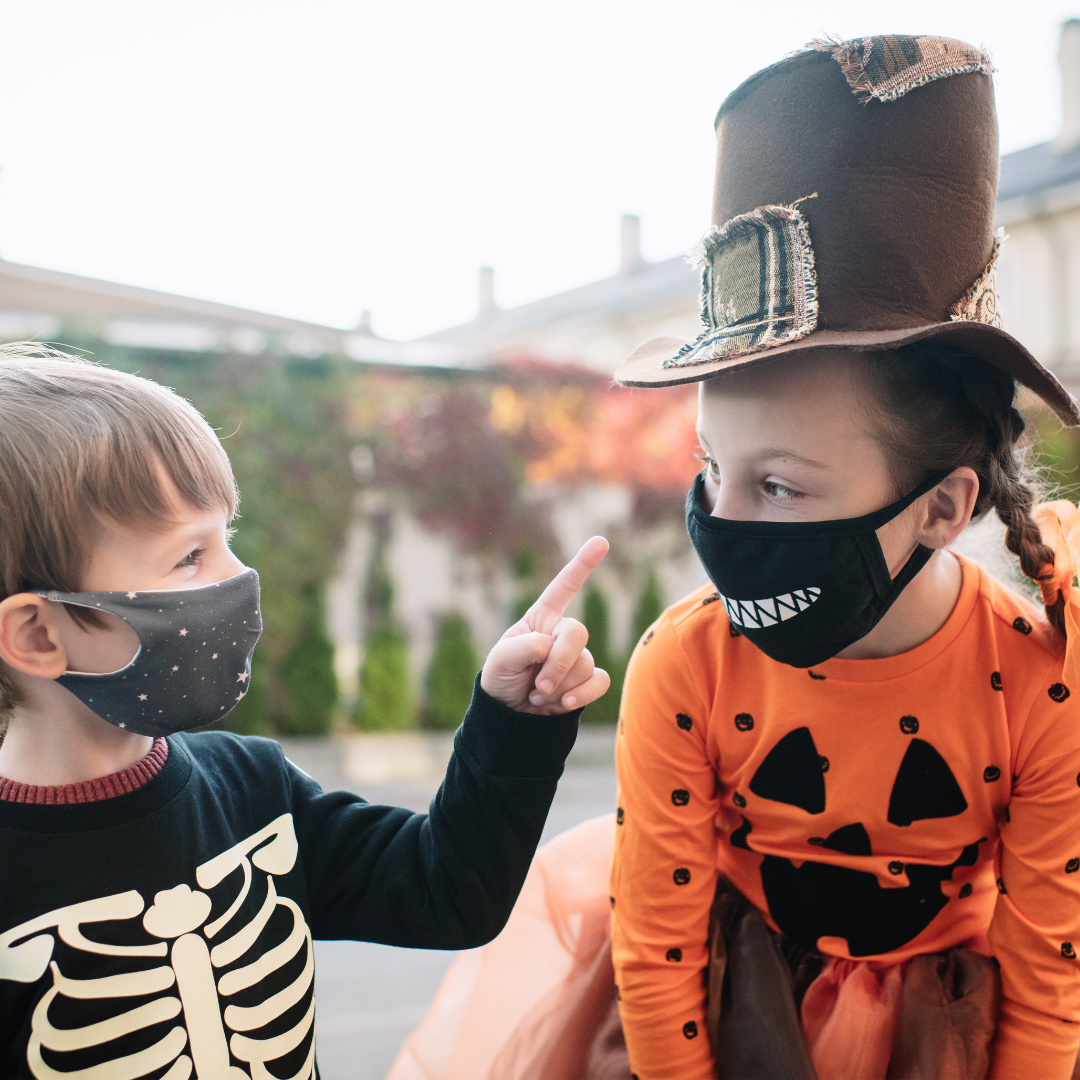This year, it’s more important than ever to keep kids safe during Halloween. While Halloween probably won’t look quite the same as usual in 2020 with the pandemic still present within our communities, kids can still have fun while adhering to recommendations for a safe Halloween. While celebrating, remember to be inclusive of all children — including those with food allergies and autism.
Halloween is fun for children, but often frightening for parents when it comes to making sure kids enjoy the holiday safely. This year, on top of making sure children follow all the usual Halloween safety guidelines, parents also need to make sure their children participate in the holiday in a safe manner with the pandemic still at large. Halloween should be enjoyable for everyone, including kids with food allergies (which affect approximately 1 in 13 children in the U.S.) and those with autism spectrum disorder (ASD), which is approximately 1 in every 54 children in the U.S. Read on for expert tips on how to make this Halloween fun, safe, and inclusive for all.
COVID-19 safety
Although COVID-19 remains a risk in many areas, there are still ways children and families can safely enjoy Halloween this year.
“It’s always best to practice risk mitigation strategies, like using social distancing and good hand hygiene,” says Chpryelle Carr, MD, a pediatrician at Atrium Health Levine Children's Waxhaw Pediatrics. “The sooner we can do that, the better the chances will be that we can keep the COVID-19 transmission rates low during the Halloween season.”
Of course, when it comes to Halloween, the number one item on most kids’ minds is trick-or-treating. According to newly released CDC (Centers for Disease Control) guidelines, traditional trick-or-treating is considered a “higher risk” activity.
“Trick-or-treating is possible, but it has to be done in a safer way,” Dr. Carr advises. “The traditional trick-or-treating, where one person is passing out candy to multiple people, or there's a bowl outside that multiple people are digging in, is not going to be safe this year.” However, there are strategies parents can use when giving out treats or taking their kids trick-or-treating.
“If you’re giving out candy, you can have treat bags or candies spaced out on a table, a yard, or a driveway,” Dr. Carr says. For kids who are trick-or-treating, make sure they wear masks — not costume masks, but cloth masks, since many Halloween costume masks won’t adequately cover the nose and mouth. “Children do not adhere to social distancing all the time, especially when there's candy involved,” says Dr. Carr. Before kids eat any candy, make sure they wash their hands for at least 20 seconds or use hand sanitizer if they don’t have access to soap and water and just can’t resist eating a treat on the go.
For even lower-risk options, Dr. Carr suggests trying a scavenger hunt with candy at your own house. Families can also host virtual parties, pumpkin decorating contests, or costume contests, or they can drive around looking at Halloween decorations. Dr. Carr also advises parents not to let children or teenagers attend indoor Halloween parties or go to indoor haunted houses. “I strongly discourage any indoor activities,” says Dr. Carr. “People can have COVID-19 and be asymptomatic, and at parties, people are often eating and drinking, which means they’re not wearing masks." Adults should also be mindful of consuming alcohol or drugs, which lowers inhibitions and the ability to properly assess and avoid risks.
Outdoor activities, like pumpkin patches, are safer as long as families don’t do things like ride on a tractor with multiple people. If possible, families should time their visits for less-crowded days or times.
 |
Food allergies
According to Ekta Shah, MD, who specializes in pediatric allergy and immunology, “Food allergies are very serious. They’re not simply food preferences and can make children very sick. For kids with food allergies, Halloween can be difficult. Some of the most common food allergens — nuts, milk, and eggs — are found in many Halloween candies.”
Of course, there are ways to celebrate Halloween without food — like pumpkin carving, parades, and dressing up in costumes — but for many children, the holiday centers around candy. “If kids want to trick-or-treat and have food allergies, but they can’t read labels yet or speak up for themselves, they have to go with a parent,” says Dr. Shah. And for children of all ages with food allergies, “Always make sure they have auto-injectable epinephrine with them.”
Parents also need to read ingredient labels carefully. If candies don’t have one on them, parents need to check the larger bag the candies came in or look up the ingredients on the candy manufacturer’s website. “The mini ones or ‘fun-sized’ ones can be processed differently from regular size candy, so parents need to watch out for potential allergens or cross-contamination,” cautions Dr. Shah. This can happen with any brand of candy.
For parents who want to make sure they offer allergy-friendly treats to kids, they can give children non-food items like glow sticks, pencils, stamps, or stickers. Putting out a teal pumpkin, an initiative of Food Allergy Research & Education (FARE), is way to indicate your house supports including children with food allergies in Halloween by offering non-food treats.
 |
Children with an autism spectrum disorder
Yasmin Senturias, MD specializes in Developmental and Behavioral Pediatrics. In her practice, she sees many children with autism spectrum disorder (ASD). Dr. Senturias says, “Halloween can be scary or overwhelming for children with ASD — even costumes that might not scare most people can frighten them.” She adds, “Even wearing a costume can be difficult for kids with ASD because of the sensory issues they can experience.” “If a child with ASD does want to wear a costume, try it on in advance,” Dr. Senturias advises. “Have a ‘dress rehearsal’ ahead of the holiday. You can even role-play and show the child pictures of what to expect. Often, these children want to participate in the fun, but at the same time, it can be frightening for them.”
Parents of children with ASD should also explain to them in advance what the holiday will entail. If the child is trick-or-treating or participating in any kind of Halloween activity, and they’re verbal, the parent can tell the child to say “thank you” when receiving a treat. For nonverbal children, have the parent offer thanks on the child’s behalf. Parents of nonverbal children with ASD may need to offer brief explanations to other children about things that can overstimulate or frighten the child with ASD, such as loud noises, being touched unexpectedly, or scary costumes. If the child is sensitive to noise, parents might consider bringing earplugs or another noise-blocking device for the child. “If you know your child is a runner, limit the number of houses you visit and don’t stray too far from home,” says Dr. Senturias.
A blue bucket or pumpkin is a signifier that a child has Autism Spectrum Disorder, as the color blue is the symbol of autism awareness. Parents can give their child a blue bucket or display a blue pumpkin to let others know their child has ASD, or that the house is friendly to children with ASD. Some children with ASD might prefer to stay home and help give out candy (following the tips above, like placing candy on a lawn or driveway). Dr. Senturias also advises that children with ASD should try to participate in Halloween festivities while it’s still light outside (something that will be easier since Halloween is on a Saturday this year). As far as candy goes, the usual rules apply about safety and pacing oneself by limiting the amount of candy consumed in a day.
 |
If you have questions about what activities are safe for you and your children this Halloween, contact your pediatrician. Need a pediatrician? Find one here.
This content originally appeared in Atrium Health's Daily Dose
Connect with Atrium Health Levine Children's



